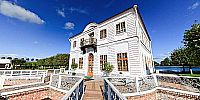© 2008 Rodion Galanev, All Rights Reserved.
One of the most marvelous former royal residences in the St. Petersburg suburbs is Peterhof. It is situated 18 miles from St. Petersburg. Peterhof is so famous due to its parks, magnificent sculptures and fountains, and, of course, the Great Palace surrounded with smaller palaces.
Peterhof was named in honor of Peter the Great, Peter the First, the Emperor of Russia, the Great Reformer, founder of St. Petersburg and Peterhof. Actually, the word “Peterhof” has a German nature – it's German for “Peter’s Court”.
Peterhof was initially founded as a monument to Russia’s victory against the Swedes. And its artistic decoration reminds us this glorious victory. At the same moment the construction of Peterhof showed ambitious plans of Peter the Great to build a residence that could compete in splendor to the famous residence of Versailles in Paris. In the year 1700 Russia started a military campaign, known as the Northern War, against Sweden. Russia intended to gain the outlet to the Baltic Sea in this war. Thus, to protect Russian territories from enemies, Peter the Great ordered to build a sea port of Saint Petersburg at the mouth of the Neva River (the Neva River is the main river of St. Petersburg). It has about 300 bridges constructed across it, 24 of them are “opening” bridges. To protect the sea port of St. Petersburg Peter the Great built a fortress of Kronstadton on Kotlin Island. Peter visited Kotlin Island many times and he had a small cosy house to stay in there. This small house became something like a beginning of the exquisite park and garden ensemble of Peterhof.
At the end of the Northern War, after the decisive victories of Gangut and Grengam and victory of Poltava in 1709, Peter the Great began the construction of Peterhof, an outstanding residence that would show the might and Glory of the Russian Empire. Construction works in Petergof were very complicated due to the marshy soil and clay (the same problems that they came across during the construction in St. Petersburg). The clay was removed and replaced with good imported soil brought from sunny regions of Russia. They brought thousands of unusual plants from all parts of Russia and Europe (Now all of the plants in Peterhof residence are taken real scientific care of).
Peter the Great was in love with his future masterpiece and did all his best to invite famous architects, among them a lot of foreigners, to create a really European residence (thus, St. Petersburg and its suburbs are the examples of “Russian European” artistic style). These are one of the most important names in the construction of Peterhof; Braunstein, Michetti, Le Blond, Zemtsov and others. After Peter the Great died Petergof was inherited by the numerous throne successors. Something was changed in the residence of Peterhof by contemporaries of new epochs, but the whole idea and the most part of the attractions were preserved.
During the Second World War Russia was practically occupied by Nazis. Anyway, St. Petersburg was in blockade (was surrounded by enemies for 900 days). Peterhof due to its close location also could not avoid being occupied. Museum staff of the residence struggled to save Peterhof's valuable articles. Some of the sculptures were buried in the ground, about 7,000 objects were evacuated. But, anyway, about 50,000 exponents were left aside “to meet Nazi” it its solemn beauty.
Peterhof was liberated in 1944. It was left by the Nazis in real ruins, they cut the major part of century-old trees, they left trenches and large dugouts all across the park territory, they ruined many park pavilions and robbed the museums completely. But, what is more, they left about 100,000 mines and shells in the ground, and afterwards there was a long and dangerous demining work in Peterhof.
Peterhof was completely restored only in our times. Nowadays there is carried out interesting work of restoring those masterpieces that were forgotten and partly destroyed not due to military actions, but with time. Thus, they restore a beautiful harbor called “Kupecheskaya.” There are many more intriguing projects in Peterhof to be launched in future.
Marli
Marli was created according to the project of a very famous architect Braunstein in the 1720s. The idea of how this palace should appear occurred to Peter the Great when he visited a residence of the French king Ludovick XVI called “Marli de Roi.” Marli is an example of how the palace and park ensembles of those times should have looked. Marli was constructed under a modern progressive idea of those times – “model projects.” As an etalon for all the other residences of wealthy people, Marli had special ponds. These ponds were not only for a palace decoration, but were used practically. There they grew different kinds of fish and they used the water from the ponds for irrigating of Marli garden. (In current times they have resumed this tradition of having fish in one of Marli ponds. The guests of Peterhof can catch a fish themselves first, and afterwards this fish is cooked for them in Marli restaurant which can boast its gorgeous interiors).
More info: http://en.wikipedia.org/wiki/Peterhof



 Tap or click the zoom icon in the bottom right corner of the picture to switch between in-page and fullscreen view
Tap or click the zoom icon in the bottom right corner of the picture to switch between in-page and fullscreen view